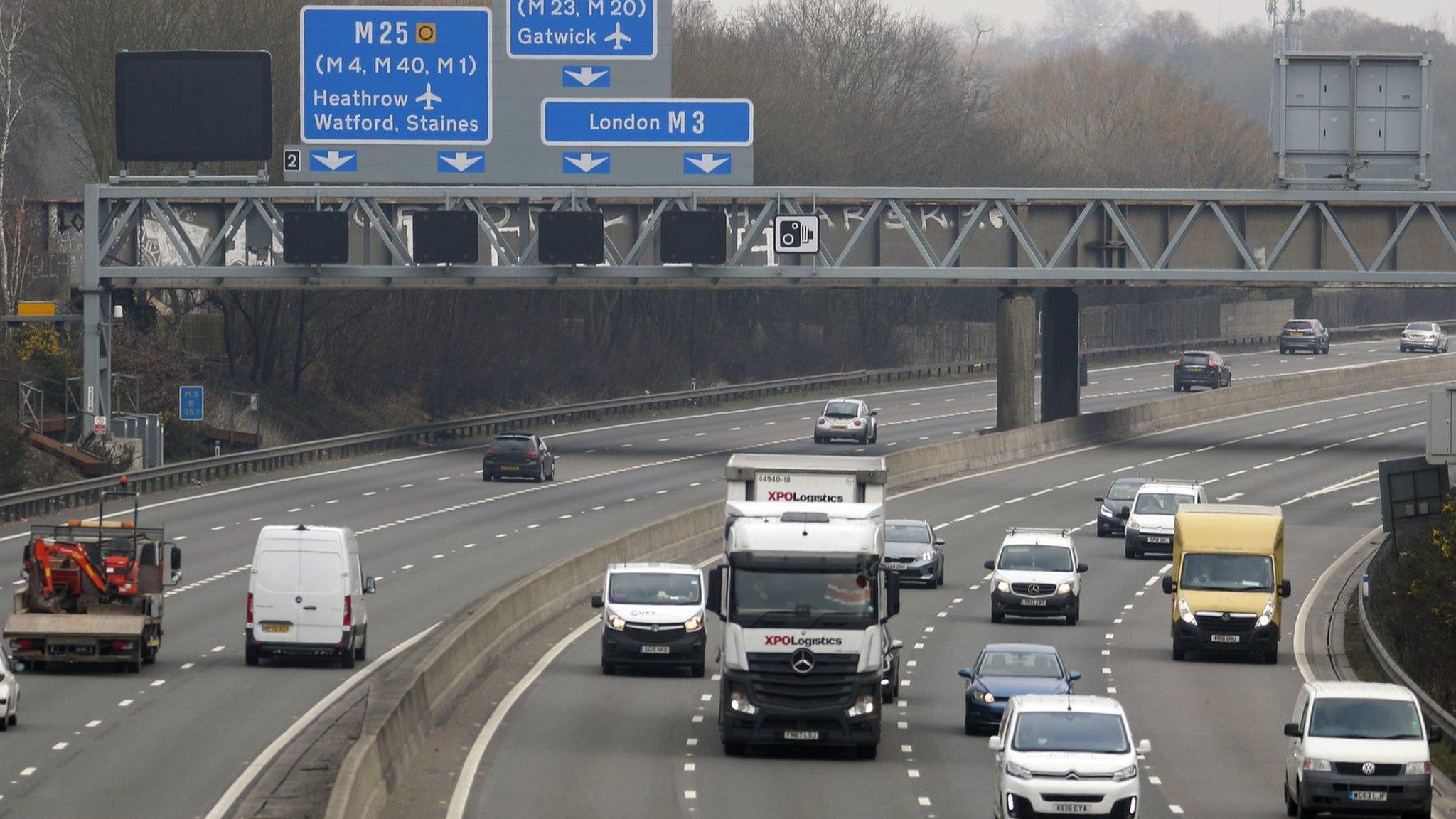National Highways: The traffic officers helping keep our roads moving
- Published
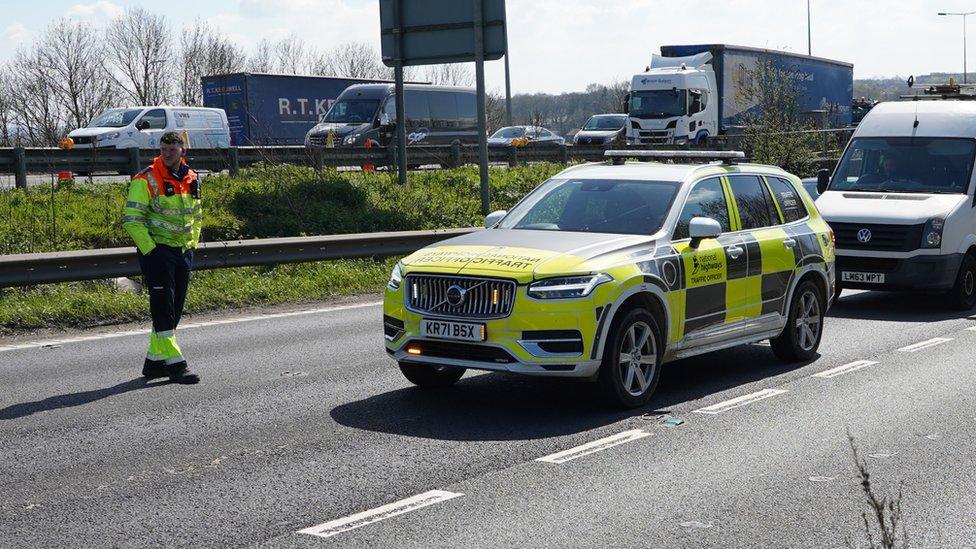
Traffic officers patrol the region's major routes including the M62, M606, M621 and parts of the M1
Just days after the government scrapped all new smart motorway plans over cost and safety concerns, the BBC spent a shift with the National Highways team in Yorkshire to see how its officers work to keep drivers safe and traffic flowing on some of the UK's busiest roads.
"This looks like a nightmare," traffic officer Tom Thackray-Collier tells me as we drive past the scene of a broken down car at the junction of the M606 and M62 near Bradford.
The small blue vehicle is stranded between the slip road and the main carriageway, where traffic usually roars past at 70mph (112km/h).
As recovery crews work to remove the stricken vehicle, Tom and his colleague, George Mitchell, are tasked with bringing the traffic to a stop.
Assessing the scene, the pair decide to stop the traffic on the slip road, using their fluorescent yellow and green checked Volvo to create a rolling road block and bring the vehicles to a stop.
Despite the orange flashing lights and 'do not pass' message displayed on the screen in the back of their car one driver still tries to squeeze past, leaving Tom and George to exchange a few choice words.
Their job heavily relies on other drivers, or "customers" as they call them, helping to keep them safe.
Speeding motorists, people using their phones or drivers just not paying attention to what is happening around them all make the job harder and more dangerous.
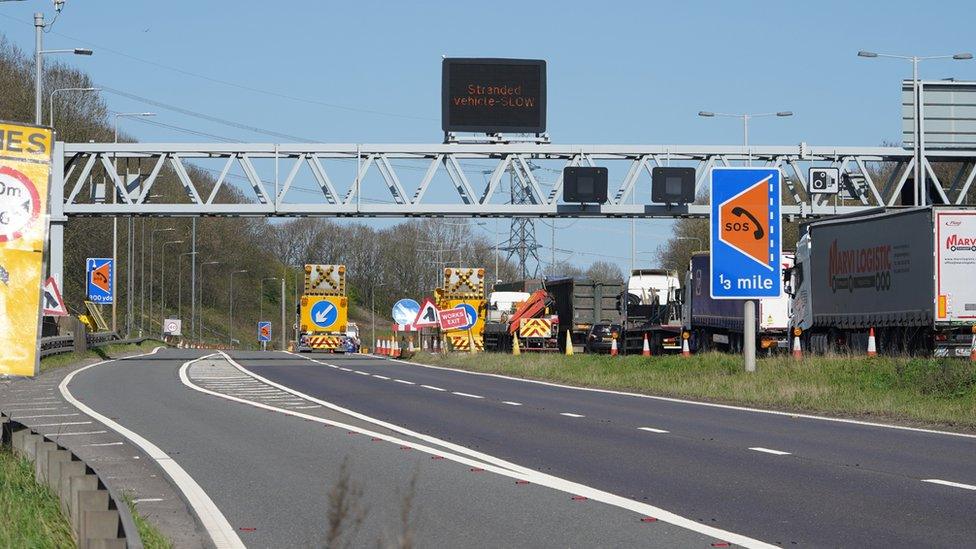
The stretch of the M62 where the breakdown happened was due to become an all-lane-running smart motorway
"This is a busy junction, traffic from several towns come into here," George tells me, shouting across the now-closed three lanes of traffic.
The gantry signs warn of the stranded vehicle, but the team have to trust drivers will follow the instructions.
This section of the road is not an all-lane-running smart motorway - where the hard shoulder has been permanently removed - but had been earmarked for conversion until the government's recent announcement.
Instead, it will remain a dynamic smart motorway, where the hard shoulder can be opened up at peak times and used as an extra lane.
Tom says his pet hate is "red X abusers" - drivers who ignore lane closures because they are not paying attention, or worse - to beat traffic.
"[One driver last week] was driving right up to the incident, but a camera flashed her. Dunno what she was thinking," he says.
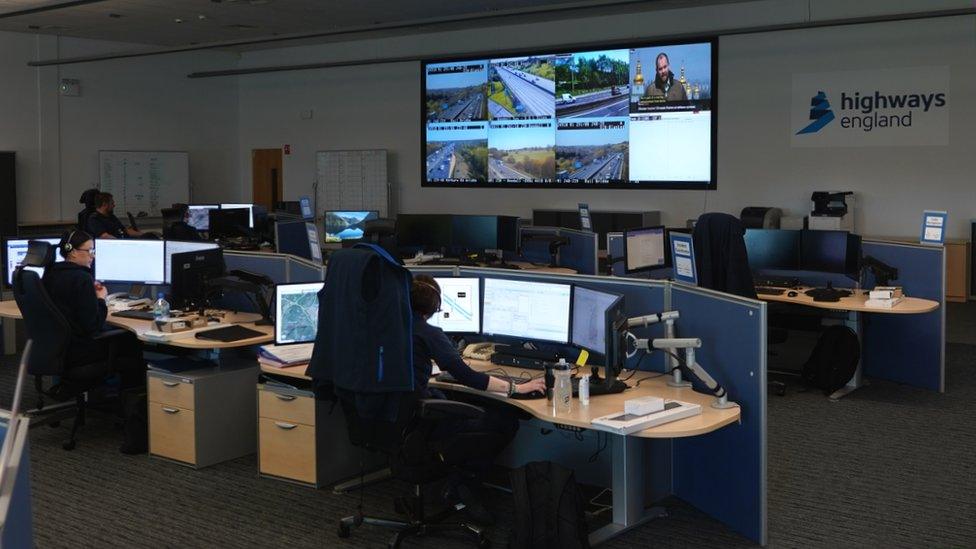
The National Highways control room in Yorkshire handles calls about breakdowns and crashes
Breakdowns, removing items from the carriageway and closing lanes at crash sites are some of the jobs traffic officers can expect on an average day.
Tom and George are part of a team of about 20 traffic offers in this area, patrolling 670-miles of motorways and A roads, stretching from Berwick down to Sheffield and from Halifax across to Hull.
National Highways introduced the crews in Yorkshire in 2005, working alongside police officers to help them keep people moving on the network.
They cannot break the speed limit or fine you, but in-car CCTV can be, and often is, used to report bad standards of driving to the police.
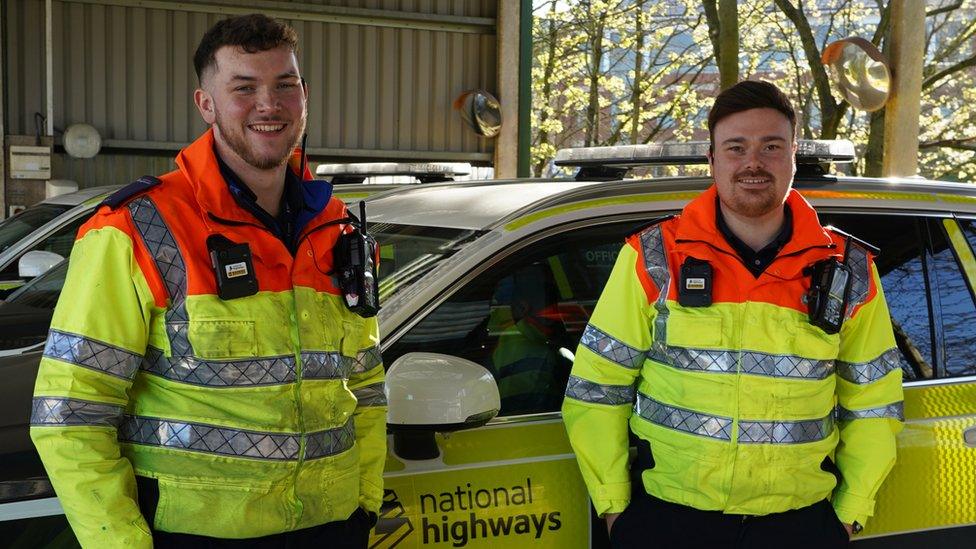
George Mitchell (left) and Tom Thackray-Collier are fairly new to the National Highways team
Driver George is fresh out of training, having only had about three months of real-world training. Before this, he worked at a supermarket warehouse in Leeds.
"It's been a steep learning curve, not every customer is the same. I love it, though," he says, glancing in the rear view mirror.
"On a busy day, it's pretty much non-stop," says Tom, who worked in the ambulance service for 10 years before swapping the blue lights for orange about a year ago.
On a normal day, crews proactively patrol the M62, M606, M621 and parts of the M1, ready to respond to incidents.
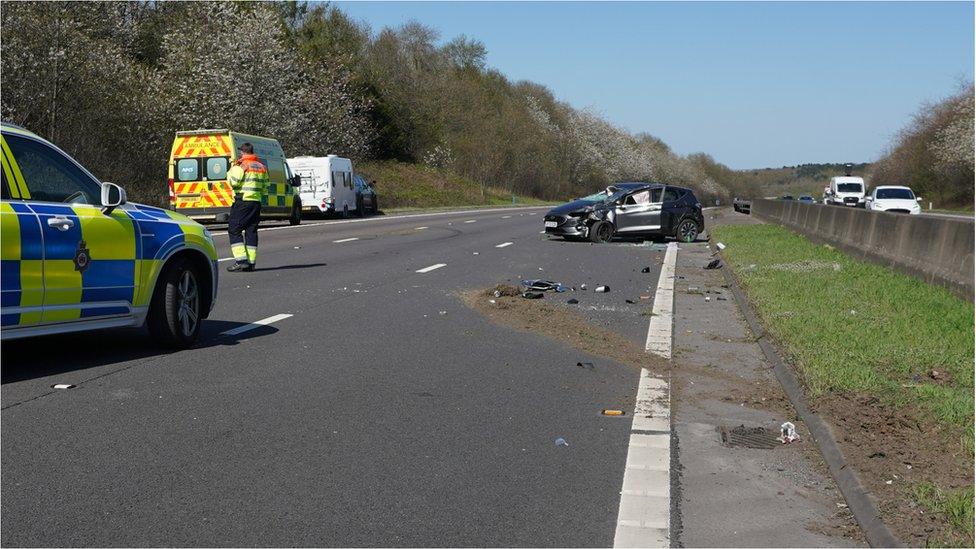
The driver of the Ford walked away with minor injuries, police at the scene said
A new shout comes through the radio.
A serious crash on the M1 has seen a car roll three times. All three emergency services are rushing to the scene, along with traffic officers to close the road.
Charlie Lima 32, our call sign, offers to help and we divert from our current route.
We are sent to Woolley Edge Services, as details are drip-fed through over the radio of a serious crash. We drive past the scene on the opposite carriageway and the trail of destruction is obvious.
On this occasion the driver has escaped with minor injuries, a police officer at the scene tells Tom. Their brand new Ford Focus, however, is not so lucky.
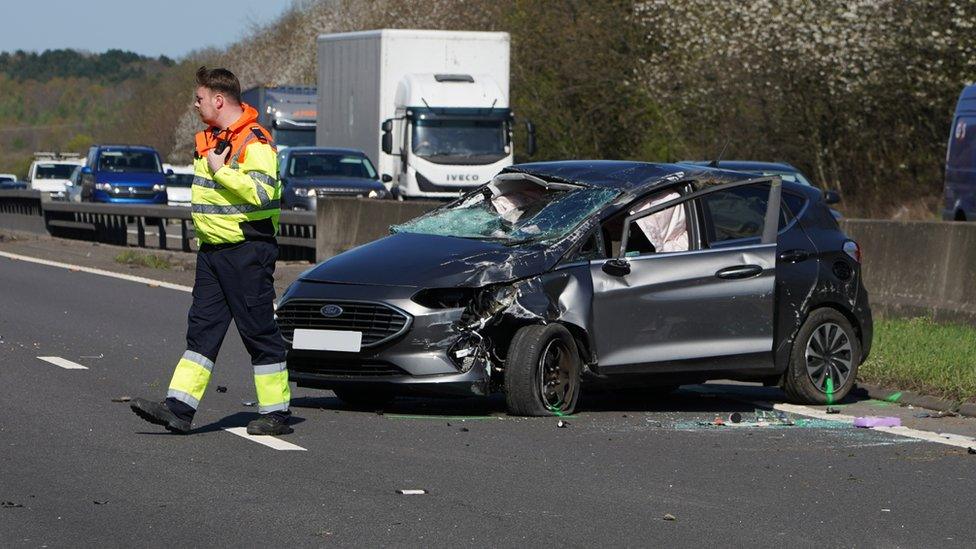
Tom is on hand to oversee efforts to move the damaged car to safety
"Suddenly there was a massive bang," Richard Raper, who was the other driver involved in the collision tells me.
He had been driving home with his daughter after a caravan holiday in Ashby-de-la-Zouch.
"[I] looked in my wing mirror and saw the other vehicle involved, maybe turning sideways and spinning. [There was] a lot of damage to my vehicle, but a lot more to hers and she's walked out alive, somehow."
With half a dozen traffic officers at the scene some work to divert motorists through the services while others are tasked with starting the clean-up operation and moving the Ford off the motorway.
Rubberneckers, staring at the mangled wreckage from the other carriageway, are a concern. Some of them film the crash scene, while others almost cause crashes themselves by not paying attention to where they are going.
Despite the concrete barrier between me and the cars moving freely southbound, the danger is obvious and the side of the motorways feels like a scary place to be.
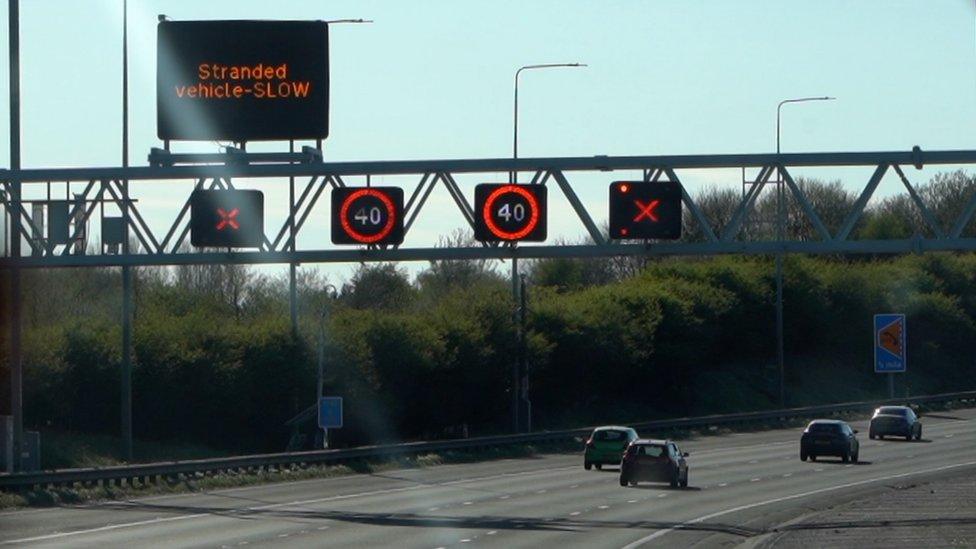
There are several stretches of smart motorway in Yorkshire
Smart motorways were designed to ease traffic flow, partly by some of them using the hard shoulder as an extra lane for vehicles, but critics claim they have led to road deaths.
According to government figures obtained by Panorama in 2020, 38 people were killed on smart motorways between 2014 and 2019 and in 2022 a coroner ruled a lack of hard shoulder contributed to the death of a grandmother after her car broke down on the M1 near Sheffield.
Matt Anthony is part of the team monitoring the region's motorways, using information from cameras, radar and regular patrols to dispatch officers to where there is an issue.
He tells me it has been "a non-stop" day, with barely a moment to look up from his computer.

Matt Anthony dispatched crews to incidents across the Yorkshire motorway and A-road network
"On this screen, we can create a log and set [overhead] signs, for example a lane-one closure, make sure that's all set straight away," he says.
Sometimes one call to the control room can see closures or speed limits lowered while the team check the reports. They can look at their wall of CCTV cameras to confirm what is happening and send crews accordingly.
It is people like Matt who send us to our next job, another live-lane breakdown on the M62.
This time a van's clutch has stopped working, marooning them in the central reservation of the busy motorway.
Two of the four lanes are closed using the overhead signs. The only thing keeping the driver safe now are the red Xs and drivers paying attention.
"Not only [does this] keep us safe, but it protects the motorist too," Tom says.
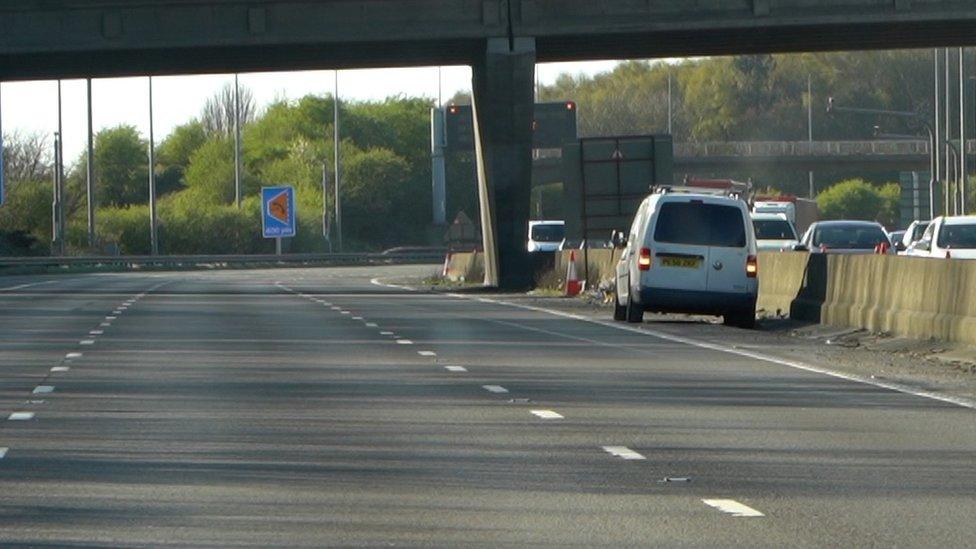
The road had to be fully closed to allow the van to be recovered
The two men are still sitting in the van as we put on a rolling road block and bring the traffic to a standstill. Once it is stopped, out come the cones to tell drivers the motorway is now closed.
The plan is to tow the van to the inside lane while they arrange their own recovery.
"We're there to help people. I know that might mean closing a road, but at the end of the day it's for customer safety. He's not safe being in the central reservation," Tom says.
The road is reopened and in just a few minutes traffic is flowing freely again. A quick radio call to the control room and the overhead signs revert back to normal.
In just a few hours, we have have had a whistle-stop tour of motorways in the patch. Not every day is this busy I'm told, but each job, even on the quiet days, helps keep the traffic flowing.
As George puts it: "When we're busy, someone's having a bad day."

Follow BBC Yorkshire on Facebook, external, Twitter, external and Instagram, external. Send your story ideas to yorkslincs.news@bbc.co.uk, external.
Related topics
- Published16 April 2023
